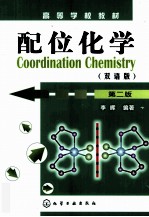图书介绍
配位化学 双语版PDF|Epub|txt|kindle电子书版本网盘下载

- 李晖编著 著
- 出版社: 北京:化学工业出版社
- ISBN:9787122109064
- 出版时间:2011
- 标注页数:262页
- 文件大小:27MB
- 文件页数:274页
- 主题词:络合物化学-高等学校-教材
PDF下载
下载说明
配位化学 双语版PDF格式电子书版下载
下载的文件为RAR压缩包。需要使用解压软件进行解压得到PDF格式图书。建议使用BT下载工具Free Download Manager进行下载,简称FDM(免费,没有广告,支持多平台)。本站资源全部打包为BT种子。所以需要使用专业的BT下载软件进行下载。如BitComet qBittorrent uTorrent等BT下载工具。迅雷目前由于本站不是热门资源。不推荐使用!后期资源热门了。安装了迅雷也可以迅雷进行下载!
(文件页数 要大于 标注页数,上中下等多册电子书除外)
注意:本站所有压缩包均有解压码: 点击下载压缩包解压工具
图书目录
Chapter1 An Introduction To Coordination Chemistry1
1.1 The History of Coordination Chemistry1
1.1.1 The Origin of Coordination Chemistry1
1.1.2 The Modern Coordination Chemistry—Werner Coordination Chemistry4
1.1.3 Extending Coordination Chemistry—Supramolecular Chemistry6
1.2 The Key Features of Coordination Complex9
1.2.1 The Concepts of Coordination Comples9
1.2.2 Classification of Ligand11
1.2.3 Coordination Number and Coordination Geometry12
1.2.4 Coordinative Unsaturation15
1.2.5 Primary and Secondary Coordination Sphere15
1.3 Nomenclature of Coordination Complex17
1.4 Isomerism of Coordination Complex20
1.4.1 Definition of Isomers20
1.4.2 Structural(or Constitutional)Isomers20
1.4.3 Stereoisomers21
1.4.4 Supramolecular Isomerism23
Chapter2 The Bonding Theories of Coordination Complex25
2.1 Symmetry in Chemistry-Group Theory25
2.1.1 Symmetry Elements25
2.1.2 Symmetry Operation26
2.1.3 Molecular Point Group26
2.1.4 Character Tables30
2.2 Valence Bond Theory32
2.2.1 Hybridization of Atomic Orbitals32
2.2.2 Molecular Shapes35
2.3 Crystal Field Theory37
2.3.1 CFT for Octahedral Geometry37
2.3.2 CFT for Tetrahedral Geometry39
2.3.3 CFT for Square Planar Geometry39
2.3.4 Factors Influencing the Magnitude of △40
2.3.5 Applications of CFT40
2.4 Molecular Orbital Theory43
2.4.1 Molecular Orbital43
2.4.2 Basic Rules of MO Theory47
2.5 Intermolecular Interaction47
2.5.1 Electrostatic Interations48
2.5.2 Hydrogen Bonding49
2.5.3 π-πStacking50
2.5.4 Van de Waals Interactions50
Chapter3 Spectroscopy of Coordination Complex52
3.1 Ultraviolet and Visible Absorption Spectroscopy(UV-Vis)52
3.1.1 Electronic Transitions53
3.1.2 Absorbing Species Containing π,σ and n Electrons53
3.1.3 Electronic Absorption Spectrum of Coordination Complex55
3.2 Infrared Spectroscopy and Roman Spectroscopy57
3.2.1 Motion of Molecule57
3.2.2 IR Spectroscopy of Coordination compound59
3.2.3 The Raman Effect and Raman Scattering63
3.2.4 Raman Selection Rules and Intensities65
3.2.5 Polarization Effects65
3.3 X-ray Powder and Single Crystal Diffraction Analysis66
3.3.1 Diffraction and Bragg’s Law66
3.3.2 X-ray Powder Diffraction Analysis67
3.3.3 X-ray Single Crystal Diffraction Analysis69
3.4 Photoelectron Spectroscopy72
3.4.1 X-ray Photoelectron Spectroscopy(XPS)73
3.4.2 Ultraviolet Photoelectron Spectroscopy(UPS)77
3.5 Nuclear Magnetic Resonance(NMR)Spectroscopy78
3.5.1 Basic Principle of NMR Spectroscopy78
3.5.2 The Nuclear Absorption of Radiation in Magnetic Field79
3.5.3 Chemical Shift80
3.5.4 Spin-Spin Coupling80
3.5.5 Some Chemical Shifts in 1H and 13C NMR81
3.6 Electron Paramagnetic Resonance(EPR)82
3.7 Circular Dichroism(CD)82
Chapter4 The Structure and Physicochemical Properties of Coordination Complex84
4.1 The Structures of Several Kinds of Coordination Complexes84
4.1.1 Organometallic Complex84
4.1.2 Cluster88
4.1.3 Macrocyclic Complex and Bioinorganic Complex89
4.1.4 Supramolecular Assemblies Containing Transition Metal Ions(Polynuclear Complex)94
4.2 Thermodynamic Properties95
4.2.1 Thermodynamic Stabllity96
4.2.2 Stability of Complexes97
4.2.3 Calculation of Species Concentrations97
4.3 Molecular Electronic Devices-Redox-active Coordination Complex98
4.3.1 Concept of Molecular Electronics98
4.3.2 Molecular Wires98
4.3.3 Molecular Switching99
4.4 Magnetic Properties of Coordination Complex100
4.4.1 Magnetic States of Material101
4.4.2 Interaction with an External Magnetic Field102
4.4.3 Diamagnetism104
4.4.4 Paramagnetism104
4.4.5 Ferromagnetism,Antiferromagnetism and Ferrimagnetism104
4.4.6 Magnetic Behaviour of Variation with Temperature106
4.5 Photochemical Properties of Coordination Complex107
4.5.1 Fundamental Properties of a Photochemical Process107
4.5.2 Artificial Photosynthesis108
Chapter 5 Kinetics and Mechanisms of Coordination Reactions111
5.1 Introductory Survey111
5.2 Reaction Mechanisms of d-block Metal Complex112
5.2.1 Associative and Dissociative Reactions113
5.2.2 Measurements of Rates113
5.2.3 Typical Reaction Coordinates114
5.3 Substitution Reactions of Coordination Complex115
5.3.1 The Three Patterns of the Reaction Mechanisms115
5.3.2 Substitution of Square Planar Metal Complex115
5.3.3 Substitution of Octahedral Complex118
5.3.4 Isomerization Reactions120
5.4 Electron Transfer Reactions of Coordination Complex121
5.4.1 Outer Sphere Electron Transfer121
5.4.2 Inner Sphere Electron Transfer122
5.5 Mechanisms of Organometallic Reactions123
5.5.1 Introduction123
5.5.2 Fundamental Reaction Types124
5.5.3 Kinetic Rate Laws for Oxidative Addition Reaction125
5.5.4 Mechanisms of Oxidative Addition Reaction126
5.5.5 Migration Reaction(“Migratory Insertions”)129
5.6 Elimination Reactions132
5.6.1 Hydrogen Elimination Reaction132
5.6.2 Reductive Hydrogen Elimination Reaction134
5.7 Homogeneous Catalysis135
5.7.1 Alkene Hydrogenation136
5.7.2 Monsanto Acetic Acid Synthesis138
5.7.3 Hydroformylation Reaction140
第1章 配位化学简介143
1.1 配位化学的发展历史143
1.1.1 配位化学的起源143
1.1.2 现代配位化学——沃纳配位理论145
1.1.3 广义配位化学——超分子化学147
1.2 配合物的基本特征149
1.2.1 配合物的概念149
1.2.2 配体的分类151
1.2.3 配位数与配位几何构型152
1.2.4 不饱和配位155
1.2.5 第一配位层和第二配位层155
1.3 配合物的命名法156
1.4 配合物的同分异构体159
1.4.1 异构体的定义159
1.4.2 结构异构体159
1.4.3 立体异构体160
1.4.4 超分子异构162
第2章 配合物的化学键理论164
2.1 化学中的对称性——群论164
2.1.1 对称元素164
2.1.2 对称操作164
2.1.3 分子点群165
2.1.4 特征标表168
2.2 价键理论169
2.2.1 原子轨道的杂化170
2.2.2 分子形状172
2.3 晶体场理论173
2.3.1 八面体构型的晶体场174
2.3.2 四面体构型的晶体场175
2.3.3 平面正方形构型的晶体场176
2.3.4 影响晶体场分裂能(△)大小的因素176
2.3.5 晶体场理论的应用177
2.4 分子轨道理论178
2.4.1 分子轨道179
2.4.2 分子轨道理论的基本原则180
2.5 分子间的相互作用182
2.5.1 静电相互作用182
2.5.2 氢键183
2.5.3 π-π堆积184
2.5.4 范德华相互作用184
第3章 配合物的现代分析表征方法186
3.1 紫外-可见吸收光谱(UV-Vis)186
3.1.1 电子跃迁186
3.1.2 含n、σ、π电子的物质的吸收186
3.1.3 配合物的电子吸收光谱188
3.2 红外光谱与拉曼光谱190
3.2.1 分子的运动类型190
3.2.2 配合物的红外光谱191
3.2.3 拉曼效应与拉曼散射194
3.2.4 拉曼选律与强度195
3.2.5 极化效应196
3.3 X-射线粉末衍射和单晶衍射分析法196
3.3.1 衍射和布拉格定律196
3.3.2 X-射线粉末衍射分析法197
3.3.3 X-射线单晶衍射分析法199
3.4 光电子能谱200
3.4.1 X-射线光电子能谱(XPS)201
3.4.2 紫外光电子能谱(UPS)204
3.5 核磁共振波谱205
3.5.1 NMR的基本原理205
3.5.2 磁场中原子核对辐射的吸收206
3.5.3 化学位移207
3.5.4 自旋-自旋偶合207
3.5.5 一些1H和13C NMR谱图中的化学位移207
3.6 电子顺磁共振(EPR)208
3.7 圆二色谱(CD)209
第4章 配合物的结构和性质210
4.1 几种类型的配合物的结构210
4.1.1 金属有机化合物210
4.1.2 簇合物213
4.1.3 大环配合物215
4.1.4 含有过渡金属离子的超分子自组装(多核配合物)219
4.2 配合物的热力学性质220
4.2.1 热力学稳定性220
4.2.2 配合物的稳定性221
4.2.3 有关物种浓度的计算221
4.3 分子电子器件——氧化还原活性配合物222
4.3.1 分子电子学的概念222
4.3.2 分子导线222
4.3.3 分子开关223
4.4 配合物的磁学性质224
4.4.1 物质的磁状态225
4.4.2 与外磁场的相互作用225
4.4.3 抗磁性227
4.4.4 顺磁性227
4.4.5 铁磁性、反铁磁性和亚铁磁性227
4.4.6 随温度变化的磁行为228
4.5 配合物的光化学性质229
4.5.1 光化学过程的基本性质229
4.5.2 人工光合作用230
第5章 配位反应的动力学和机理233
5.1 简介233
5.2 d区金属配合物的反应机理234
5.2.1 缔合和离解反应234
5.2.2 反应速率的测量234
5.2.3 典型的反应进程坐标235
5.3 配合物的取代反应236
5.3.1 反应机理的三种模式236
5.3.2 平面正方形金属配合物的取代237
5.3.3 八面体配合物的取代239
5.3.4 异构化反应240
5.4 配合物的电子转移反应241
5.4.1 外层电子转移242
5.4.2 内层电子转移242
5.5 金属有机反应机理243
5.5.1 简介243
5.5.2 基本反应类型244
5.5.3 氧化加成反应的动力学速率公式245
5.5.4 氧化加成反应的机理246
5.5.5 迁移反应(“迁移插入”)248
5.6 消除反应252
5.6.1 氢的消除反应252
5.6.2 还原脱氢反应253
5.7 均相催化255
5.7.1 烯烃加氢256
5.7.2 Monsanto醋酸合成257
5.7.3 酰氢化反应259
参考文献262